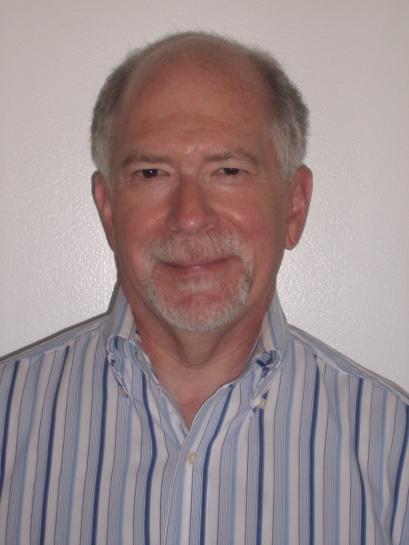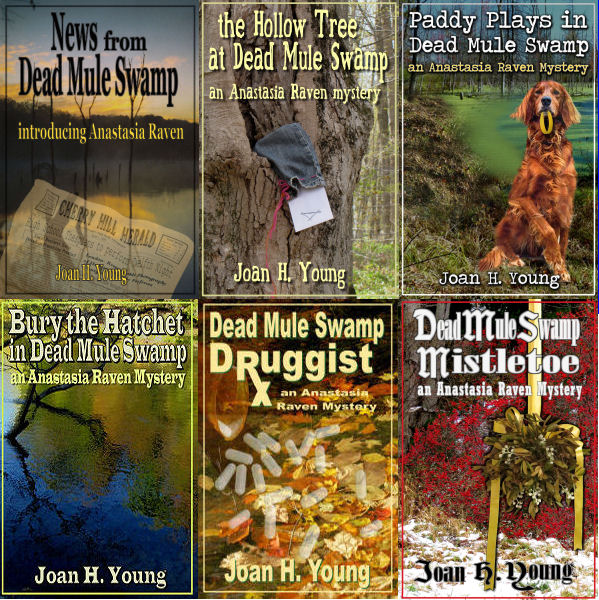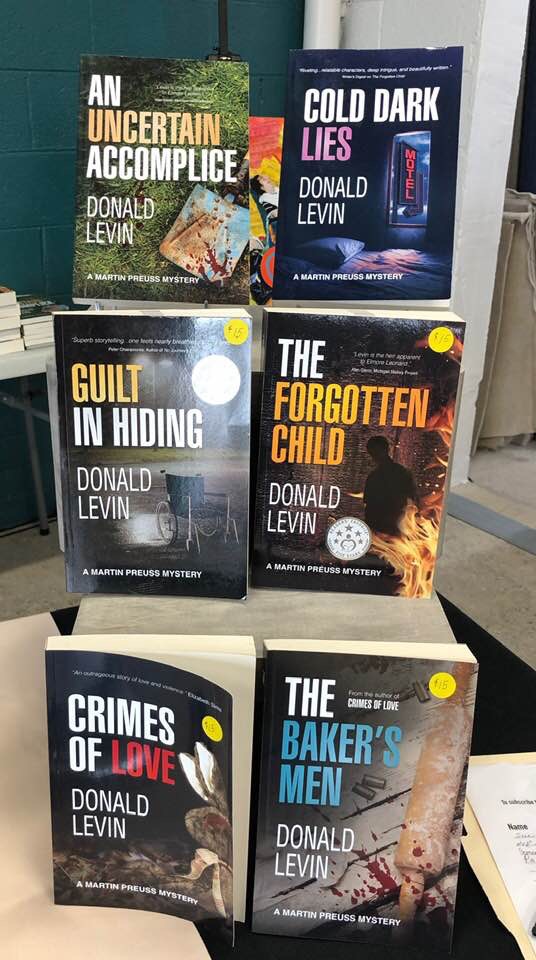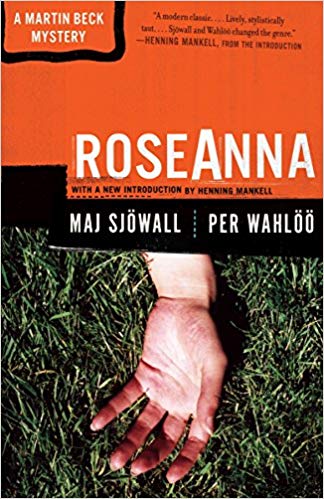About six months ago, my friend Andrew Lark invited me to take part in a project he was then developing. He was in the middle of writing the novella that would become “Pollen,” a work of dystopian fiction imagining the end of humanity, and his idea was to include two other novellas to round out a volume with that theme.
He also invited our mutual friend author Wendy Thomson. Wendy and I both jumped at the chance. We had read and respected Andrew’s previous novel, Better Boxed and Forgotten, and we all respected each other’s work. This included Wendy’s two books, a memoir, Summon the Tiger, and a novel, The Third Order, as well as my own Martin Preuss mystery series.

The result of our collaboration was Postcards from the Future: A Triptych on Humanity’s End, published this month (please see the end of the post for details of our book launch on November 2nd.) Besides Andrew’s “Pollen,” Wendy contributed a novella, “Silo Six,” and I added “The Bright and Darkened Lands of the Earth.”
People who know my work wondered if this project represented a departure from my mystery series. But I didn’t see it as a departure at all. True, dystopian fiction is a different genre than mysteries. But in a way, my contribution to Postcards is a mirror image of a mystery novel.
Mysteries, after all, generally start in a state of disorder (a crime has been committed or the social order has been upset somehow) and proceed to a state of order (the crime is solved, the social order is restored).
A dystopian or post-apocalyptic work, on the other hand, often starts with society in a state of order and then proceeds to disorder through some apocalyptic event or events. Or, as Newton’s second law of thermodynamics predicts, things move into a state of increasing disorder in the world of the work.
There’s also another way this isn’t a departure for me: I’ve long been a fan of post-apocalyptic fiction. It appeals to my cynical sense that “the crust of civilization on which we tread,” as scholar Timothy Garton Ash has written, “is always wafer thin. One tremor and you’ve fallen through, scratching and gouging for your life like a wild dog.”
My appreciation for post-apocalyptic fiction culminated in a senior seminar I developed at the college where I used to teach. As the capstone experience for English and Language Arts majors, the course, titled Post-Apocalyptic American Fiction, required students to prepare an extensive paper derived from in-depth critical reading and research on the topic, then make a public presentation of that paper.
Students were expected to draw upon the critical and analytical powers they had honed in their literature, criticism, and writing courses throughout their previous semesters.
To prepare the course, I read widely and deeply in post-apocalyptic literature, from the beginning (the biblical book of Revelation) to the most recent (at that time, The Hunger Games), from the classic (A Canticle for Leibowitz) to the popular (The Walking Dead), from goremeisters to the finest “literary” authors.
I read books about zombies, vampires, nuclear war, electromagnetic pulses, and crumbling societies in the past, present, and future. I read what critics had to say about them.
For my final reading list, I settled on four novels that represented what I thought were among the most fascinating, daring, and thoughtful works of contemporary post-apocalyptic literature, while still offering at least a glimmer of hope: Margaret Atwood’s Oryx and Crake (I interpreted “American” to include “North American because I wanted her in), Octavia Butler’s The Parable of the Sower, Cormac McCarthy’s The Road, and Colson Whitehead’s Zone One.
I loved this quartet of novels. I had previously taught senior seminars that were among my most rewarding teaching experiences, so I was tremendously excited about the course. I couldn’t wait to teach it.
Unfortunately, it was, to put it bluntly, a disaster in almost every way.
This particular group of students didn’t understand the books; they didn’t know how to read the research about the books; they didn’t know how to approach a long, segmented critical paper; though seniors, they didn’t know how to incorporate outside sources gracefully; they didn’t have a handle on critical theories or how to use them; they couldn’t grasp the not-so-subtle rules of plagiarism . . .
Please note I’m not mocking or blaming the students here, but rather commenting on their lack of preparation for the rigors of the experience—which of course was our failure as faculty in the department.
I taught the course twice, in the fall and winter semesters. It didn’t get any better from one semester to the other. To make matters worse, I got pneumonia at the beginning of the first semester and was never at my best during the entire four months of the fall.
Needless to say, it was not my finest hour as a professor. As it happened, these two senior seminars turned out to be the last undergraduate courses I would ever teach; the following summer I was appointed dean of the faculty, and except for a few graduate courses I spent the rest of my time until retirement as an administrator.
(Which was a dystopian nightmare of a whole different order of magnitude, but that’s a story for another day.)
So when Andrew invited me into his project, I was coming from a deep involvement in, and appreciation for, dystopian literature. Naturally, I said yes at once.
Because of that background, I’m particularly proud of the book the three of us produced.
Both Andrew and Wendy’s pieces are splendid, not simply as works of dystopian fiction, but as serious and thought-provoking works of literature. As one reviewer said, the novellas in Postcards are “fascinating,” “powerful,” “inviting,” and “tense, bleak, and entirely human narrative[s].”
For myself, I had such a good time on this project that I’ve begun writing a spin-off from my contribution, and have been envisioning an entire cycle of works set in the world I imagined (which I’m starting to call the Dry Earth Series).
I’d like to share a small section of my novella with you here, in hopes you’ll be interested enough to have a look at the entire book.
And if you’re in the metropolitan Detroit area, I invite you to the party celebrating the official launch of this project on Saturday, November 2nd, from 1 till 4 pm, at the historic Arden Park Kresge Mansion, 74 Arden Park Boulevard, Detroit. To register, go to www.alarksperch.com and hit the Comment button. It’s free and open to the public, but we suggest a contribution to charity.
I’m happy to present an excerpt from my novella in Postcards from the Future, the first two chapters of “The Bright and Darkened Lands of the Earth.”
1
A figure appears in an empty window frame halfway up the ruined wall. Dark glasses in a face wrapped with rags and shaded beneath a hood stare down at her.
The long barrel of a gun points in her direction.
Caught completely out in the open, she has no time to do anything except dive to the ground. She tries to merge with the rubble, disappear into it, though she knows she can’t; she is completely exposed. She holds her breath, waiting for the kill shot. She had thought there were no bullets left anymore, but she doesn’t want to take any chances.
When the kill shot doesn’t come, she dares to lift her head. The window frame is empty.
She scrambles to her feet and turns to flee.
Before going ten feet, she comes face-to-face with the hooded figure holding his rifle.
“Halt!” the figure rasps. The voice is muffled by the layers of rags wrapped around its head beneath the hood. But there is no mistaking the rough, deep sound.
It is a raggedman’s voice.
She falls to her knees and raises trembling hands.
2
Her day started hours earlier, when the wary young woman—whose name is Ash—picked her way through the debris near the entrance to her underground settlement.
With a staff for balance and protection, she stepped over concrete blocks and ragged piles of broken bricks under the heat of the unrelenting sun. Several times she tripped over planks of charred wood from buildings that had been destroyed in the old wars, concealed under the red dust that coats the land.
Her destination was a few clicks away from their settlement. Wreckage like what surrounded the underground opening was everywhere, all along the meandering path she traveled. They were taught to avoid moving in a straight line to present less of a target, and also to increase the chances of scavenging valuables buried away from the common paths.
The woman stumbled over the detritus of what was left of the city. She wore a tattered drab coat wrapped around her despite the heat, and she protected her head with an ancient battered welder’s helmet that was the unit’s only armor against the brilliantly bright, deadly rays of the sun. This was one among a cache of similar helmets that had been scavenged over the years. Nobody knew what they were at first, but when the tribe discovered the helmets’ uses, they became treasured finds.
She walked carefully, alert to every movement around her. No animals or insects survived anymore, so chances were any movement would be hostile. The only sound was the wind soughing against the metal of her helmet. She swiveled her head constantly. The helmet restricted her view, but its protection against the damaging rays of the sun outweighed any limitations to her vision.
Ash walked over the streets, cracked and overgrown with the skeletal remains of trees and bushes. No one could remember the last time it had rained, not even the elders; plant life had turned brown and desiccated in the absence of water, disappearing like the animals.
Her destination rose ahead of her. It was a larger building than most in the area, originally three stories tall. One entire wall had fallen over in the tremor that rolled through the land the day before.
After a collapse was the worst time to be out scavenging. The dangers from old structures were multiplied after one toppled; the ground grows unsteady around them, so the ones nearby are liable to let go and fall, too. The mortar between blocks is dry, the ruined buildings unstable.
Their original purposes have been lost, but their current usefulness sometimes surprises the survivors who venture from their underground settlement to scavenge. While most such buildings, like the one Ash sought, had long been emptied of any water or food, they sometimes yielded tools or pieces of clothing or other prizes that made exploring them worth the danger. Especially after a collapse, which often uncovered treasures previously hidden to the Vengers who searched.
Ash is a Venger. When Vengers found objects that might be of use, they would bring them back to the settlement. If they found potential food sources, they were to return and inform their work unit’s leader, who would let the Vesters know. They, in turn, would go out and harvest the food. The practice had developed to ensure their survival, and so far it was working, if barely; Ash’s settlement was on the verge of starvation.
Slowly the food sources have been dwindling. As they did, so too did the tribe. The Vengers had to travel further and further from their underground settlement to find food, and sometimes they returned empty-handed and sometimes they did not return at all.
Ash paused when she was about a half-click away from the structure she sought. She scanned the sight through the dark glass of her helmet. Then, stepping carefully while still some distance away, she circled the ruin once, twice, three times, all the while keeping watch for anything moving in the wreckage. It wouldn’t take much to overwhelm her; one raggedman alone could do it if he caught her by surprise.
On her third circuit around the building, a sound reached her, penetrating her helmet. It was high and keening. Though she had not heard a baby cry in years, this brought back the sound of an infant’s mewl. Of course that would be impossible; few children have been born in the recent past. And no child would have survived for long in the outside.
She stopped, knelt low, and listened. The crying ceased, but then she heard what she thought was pounding. She raised the faceplate of her helmet, aware as she did that she was allowing the deadly radiation inside the metal. But she needed to find out what the sound was.
She lifted her head, with the helmet guard ajar so she could see into the shadows that surrounded the building. She listened but heard no more wailing.
Then she heard a scratching and scrambling in the rubble. She stood perfectly still, aware that she was unprotected outside the ruins of the building.
And that this might be a trap.
Then she looked up and saw the figure with the long gun in the empty window frame.
###
Postcards from the Future: A Triptych on Humanity’s End, by Andrew Charles Lark, Donald Levin, and Wendy Sura Thomson, is available in paperback and Kindle from Amazon.com and on order from your local bookstore.

 Chene is a Sergeant with the Michigan State Police, part of a squad of detectives that work on major cases. Most of their assignments center around investigations that cover multiple municipal jurisdictions. This story is about a successful businessman who is murdered at a paintball game. With over a hundred suspects to consider, Chene and his team know this won’t be an easy case to solve. It doesn’t take long to figure out that this victim was no choirboy and more than one person wanted him dead. Every turn brings out more suspects. Soon they’re looking into illicit affairs, possible connections with organized crime, and a fortune in jewels.
Chene is a Sergeant with the Michigan State Police, part of a squad of detectives that work on major cases. Most of their assignments center around investigations that cover multiple municipal jurisdictions. This story is about a successful businessman who is murdered at a paintball game. With over a hundred suspects to consider, Chene and his team know this won’t be an easy case to solve. It doesn’t take long to figure out that this victim was no choirboy and more than one person wanted him dead. Every turn brings out more suspects. Soon they’re looking into illicit affairs, possible connections with organized crime, and a fortune in jewels.















